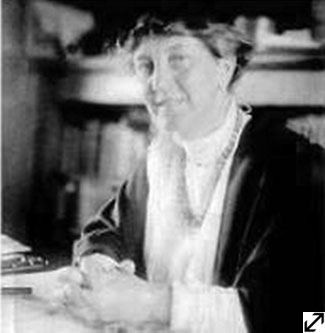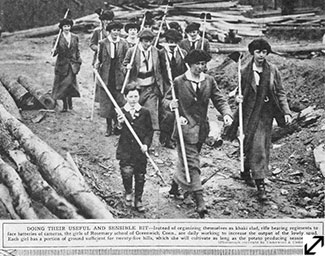1917–1918 The United States Joins the Fight
Doing Their Bit—Student Contributions
Children made up an important part of the volunteer work force. As Greenwich resident Alexandra Spann remembered later in life, once the War started she stopped playing after school. Instead, she went with her mother to help with Red Cross efforts at the YMCA. A main activity there was knitting garments and accessories for soldiers. Similarly, Horace H. Bassett recalled how he and his boyhood friends knit squares that were assembled into afghan bed coverings at school. He also recalled how the children saved their peach pits and shells of nuts that were gathered at school for use in gas mask filters. At times in these young lives, it must have seemed as if every act had some impact on the War's outcome.

Caroline Ruutz-Rees (1865-1954). Courtesy of Choate Rosemary Hall Archives.
Caroline Ruutz-Rees, headmistress of Rosemary Hall from 1890 to 1938, held a Lady Literate in Arts degree from the University of St. Andrews and a doctorate from Columbia. She believed strongly that girls should learn the same lessons as boys. Under her leadership the mission of Rosemary Hall changed from an emphasis on the domestic arts to a rigorous academic program and student self-government along with a strong athletic program.

Letter from Clarissa MacRae to Elmer MacRae, February 7, 1917. Greenwich Historical Society, William E. Finch, Jr. Archives, Holley-MacRae Family Papers.
In this letter Clarissa MacRae described a lunchtime presentation at Greenwich Academy on the bullets Remington Arms produced for various European countries.


